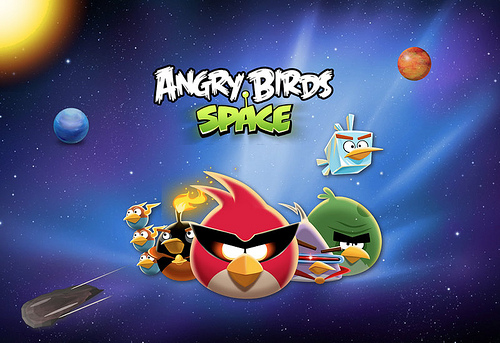By Joel Smart (The Cascade) – Email
Print Edition: March 28, 2012
Although Angry Birds has had a few different iterations since its original release—Angry Birds Seasons and Angry Birds Rio—each one has functioned more as a level pack than a true sequel. Things have changed in the latest release, as Rovio has opted to take the game, literally, out of this world.
What really sets the game apart from the traditional Angry Birds experience is the inclusion of gravity fields. While an entire level operated with the same, default “Earth” gravity in previous games, gravity is now only present within certain indicated areas within a level. In most levels, players slingshot birds from one asteroid-sized planet to several others with varying degrees of gravitational pull. It adds an increased level of difficulty, as well as several new techniques for completing a level. For example, you might choose to shoot downwards, under a planet, instead of the classic upward-arch used in previous games. As well, some levels skip gravity altogether, allowing players to shoot in a straight line through space. If nothing else, it gives the game a completely different “feel” from its predecessors.
Adding to the changes are two new birds. In previous versions there were birds that had the ability to speed up, split into three, or even drop bombs. Adding to the mix in this edition are the laser bird and the ice bird. The laser bird can be shot off in any direction midway through its trajectory – you can even shoot it back towards the direction you shot it from. The ice bird, on the other hand, freezes anything it comes into contact with, allowing the next shot to shatter the frozen area in a single hit.
While it’s true that the game loses some of its classic charm by adopting such a new play style, it’s good to see the developers finally innovating after relying on the original premise for so long after the original game came out. I would argue that the game actually does maintain the Angry Birds “feel” well enough that fans of the original will easily transition into the new play style – with perhaps just a few “retries” needed to master the idea of the various gravity fields. But, then again, trial-and-error has always been the basic premise for the game.
Also new to the series: Boss fights. Although they function similarly to a traditional level, taking turns shooting birds from a slingshot, the objective is to defeat a large, more difficult enemy (it tends to be moving around) rather than stationary pigs like in most levels. It’s an interesting new challenge that expands the scope and variety of levels within the game. It’s a bit of a throwback to the classic boss fights from old arcade games.
The game also pays homage to early video games through the inclusion of five bonus levels, unlocked by finding golden eggs scattered amongst the levels. Each of these levels is based on a classic game, from Super Mario Brothers to Space Invaders. It’s a fun little inclusion that nostalgic gamers will really get a kick out of.
The only real controversy surrounding the game is the fact that despite paying for the game, Rovio is still asking players to pay more for the game’s final 29 levels, in a section called the “Danger Zone” – only the first of the 30 levels is free. However, considering the game already has 60 levels—30 in each of the game’s first two zones—there is plenty of content there for gamers.
The game is currently available for free (with ads) to Android users, as well as an ad-free 99 cent version. It’s also available on iOS for iPhone and iPad for 99 cents, or $2.99 for the iPad HD edition. Mac users can also download it onto their computer for $4.99, while PC users can purchase the game for $5.95. As for a free version of Angry Birds Space on Google Chrome or on Facebook, so far nothing has been announced. But, as seems to be the case with Rovio, it may just be a matter of time.

